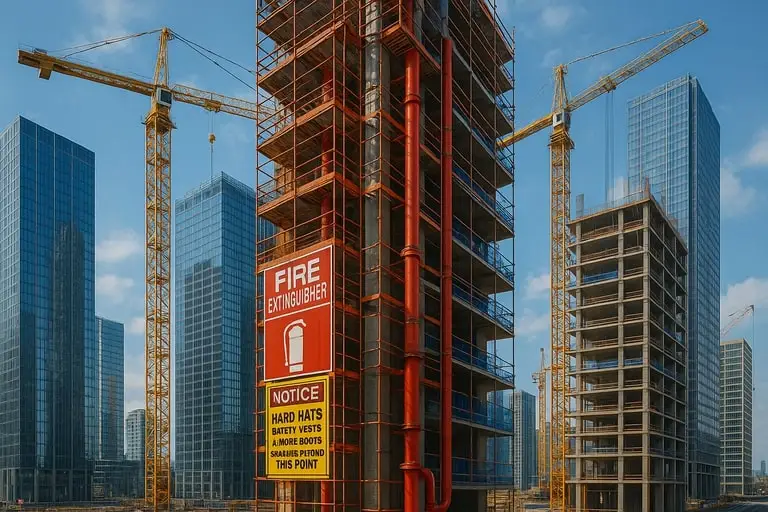Building safety standards establish the foundation of modern construction by setting requirements that ensure every project achieves durability, compliance, and protection for occupants. These standards encompass far more than basic regulations—they embody practices designed to safeguard life, property, and long-term sustainability. By integrating technical specifications with evolving knowledge, building safety standards guarantee that structures can withstand both expected and unforeseen stresses. This emphasis transforms construction from an act of assembly into a discipline of responsibility.
Compliance with safety standards in buildings has a profound impact on design and execution. Architects and engineers must incorporate load-bearing calculations, fire-resistance protocols, and material testing into every stage of planning. Adherence ensures that vulnerabilities are addressed before they manifest as hazards. Without such oversight, buildings risk becoming liabilities rather than assets, undermining trust and creating potential harm. Safety compliance therefore acts as both a legal requirement and a moral imperative.
Structural integrity serves as a central theme within building safety standards. From earthquake resistance to wind load capacity, codes define benchmarks that determine how buildings respond to stress. When enforced, they minimize catastrophic failures by ensuring that every component performs within safe thresholds. Project managers and contractors work within this framework, aligning construction strategies to meet defined performance levels. The emphasis on integrity ensures not only longevity but also confidence among communities that rely on secure environments.
Global building safety standards highlight how interconnected construction practices have become. International benchmarks such as ISO codes and seismic guidelines influence national and regional frameworks, creating a shared language of safety. This global alignment allows knowledge exchange across borders, raising the quality of construction worldwide. Countries adopt and adapt these models, ensuring local needs are addressed while maintaining global consistency. This harmonization strengthens resilience across regions facing diverse environmental challenges.
Technology enhances the application of building safety standards by enabling precise modeling and real-time monitoring. Tools such as Building Information Modeling (BIM) allow designers to test structures virtually against different scenarios, reducing risks during execution. Sensors embedded in modern buildings track vibrations, temperature, and load variations, ensuring compliance throughout a building’s lifespan. The integration of digital oversight transforms standards from static codes into dynamic processes, providing ongoing assurance of safety.
Urban development intensifies the importance of safety standards in buildings. As cities grow denser, structures must balance efficiency with resilience. Fire evacuation systems, accessible design, and energy-efficient safety measures become central to urban planning. Project managers ensure that new projects do not simply meet minimum compliance but contribute to broader goals of sustainable and safe urban living. In such environments, building safety standards act as essential guides for harmonious growth.
Sustainability aligns with safety as modern construction expands its responsibilities. Material choices must not only support structural integrity but also minimize environmental harm. Low-carbon concrete, recyclable metals, and engineered timber offer pathways to reduce ecological impact without compromising safety. Standards evolve to accommodate these innovations, ensuring that the pursuit of sustainability does not introduce unforeseen vulnerabilities. This alignment reinforces the dual commitment to both safety and environmental responsibility.
Workforce protection reflects another dimension of building safety standards. Construction sites are inherently hazardous, and compliance frameworks establish rules for equipment use, fall prevention, and on-site monitoring. By enforcing strict safety cultures, project managers safeguard workers while setting precedents for accountability. The ripple effect extends to the completed buildings themselves, which embody the discipline of safety observed during their creation. This continuity ensures that protection remains constant from inception to occupation.
Financial stability is also enhanced by compliance with building safety standards. Projects that adhere to regulations avoid costly litigation, penalties, and retrofitting expenses. Insurance providers reward compliance with lower premiums, recognizing the reduced risks associated with certified safety. Investors gain confidence in projects that prioritize standards, ensuring smoother funding and stronger reputations. In this way, safety becomes not just a protective measure but a competitive advantage in the construction industry.
Community trust depends on visible commitment to safety. Residents, businesses, and stakeholders place faith in buildings that demonstrate adherence to standards. Transparency in compliance builds credibility, ensuring acceptance of new developments. In contrast, neglect undermines public confidence and invites resistance. Project managers who prioritize safety create structures that symbolize reliability, strengthening bonds between builders and the societies they serve.
Ultimately, building safety standards transform construction into a field where accountability and vision merge. By embedding safety into every decision, professionals create spaces that protect lives, withstand challenges, and contribute to sustainable growth. These standards embody the principle that construction is not only about raising walls but about shaping environments that endure responsibly. They provide the blueprint for resilience in an evolving world, where safety remains the measure of lasting success.
Building Safety Standards in Compliance Practices
Building safety standards in compliance practices emphasize accountability at every stage of construction. Compliance ensures that regulations translate into concrete actions, from design approvals to site inspections. Without enforcement, standards remain theoretical. With compliance, they become living systems that govern how materials are used, how structures are tested, and how risks are mitigated. This transformation guarantees that every phase of a project contributes to the safety of its final outcome.
Regulatory bodies play a critical role in overseeing compliance with safety standards in buildings. These authorities conduct inspections, issue certifications, and ensure that violations are corrected promptly. Their oversight provides a framework of accountability that compels builders to align ambition with responsibility. When regulatory enforcement is strong, compliance becomes a norm rather than an exception, raising the overall quality of construction across industries.
Compliance requires collaboration across disciplines. Architects must integrate safety codes into design, engineers must validate structural integrity, and contractors must implement protocols on-site. Project managers coordinate these roles, ensuring that no detail is overlooked. This collaboration transforms compliance from a checklist into a culture of shared responsibility. Each participant in the building process becomes a custodian of safety, reinforcing collective accountability.
Technology advances streamline compliance practices by automating documentation and monitoring. Digital platforms allow project managers to track inspections, verify material certifications, and update records in real-time. This transparency reduces opportunities for oversight and ensures that safety data remains accessible for audits. Compliance thus becomes more efficient, less bureaucratic, and more reliable. The digital shift reduces errors while accelerating approvals, strengthening adherence without slowing progress.
International influence shapes compliance frameworks by encouraging alignment with global building safety standards. Cross-border projects require adherence to multiple jurisdictions, pushing companies to adopt international best practices. This blending of regulations promotes consistency and raises global benchmarks. Compliance officers ensure that local adaptations do not dilute core safety principles, creating projects that meet both local needs and international expectations.
Workforce training is central to compliance. Workers must understand not only what standards require but why they matter. Training programs instill a culture of safety that extends beyond technical rules into behavioral norms. Compliance officers enforce these practices through regular drills, refresher courses, and performance reviews. This approach ensures that safety standards remain embedded in daily routines rather than relegated to policy documents.
Risk assessment enhances compliance by anticipating challenges. Every project carries unique vulnerabilities, whether related to geology, climate, or urban density. Compliance frameworks incorporate risk analysis, ensuring that mitigation strategies are in place. By addressing risks before they manifest, compliance practices prevent disruptions and strengthen the resilience of projects. This proactive stance transforms compliance from reactionary enforcement into anticipatory stewardship.
Financial oversight ensures that compliance is not undermined by cost-cutting. Project managers allocate budgets specifically for safety, recognizing that short-term savings can create long-term liabilities. Compliance becomes non-negotiable when financial planning integrates it as a core requirement. Investors respond positively to such commitments, recognizing the stability and credibility that come from responsible practices.
Community engagement strengthens compliance by making safety a visible priority. Transparent communication about inspections, certifications, and emergency preparedness reassures stakeholders. Communities gain confidence when they see compliance upheld not only by law but by ethical responsibility. This transparency fosters acceptance and support, ensuring that projects integrate seamlessly into their environments.
Continuous improvement defines effective compliance practices. Standards evolve as knowledge advances, and compliance must adapt in step. Project managers monitor changes in regulations and update practices accordingly. This adaptability ensures that buildings remain compliant throughout their lifespan, not only at the moment of completion. By embracing evolution, compliance practices remain relevant and forward-looking.
In essence, building safety standards in compliance practices serve as the bridge between regulation and reality. They transform abstract codes into tangible protections that safeguard lives and investments. Compliance is not a static requirement but a dynamic process that demands vigilance, collaboration, and innovation. Its strength lies in its ability to embed safety into every decision, ensuring that construction remains a field where responsibility defines success.
Building Safety Standards for Global Construction
Building safety standards for global construction reflect the interconnected nature of today’s industry, where knowledge, technology, and expertise transcend borders. Global construction requires frameworks that accommodate diverse environments while maintaining consistent levels of protection. These standards provide the foundation for safe practices across regions with different climates, geologies, and urban densities. By uniting international expectations with local realities, global construction demonstrates the universal relevance of safety.
International organizations play a central role in shaping global building safety standards. Bodies such as the International Code Council and ISO develop frameworks that countries adopt and adapt. These models serve as benchmarks for national codes, ensuring consistency while allowing local flexibility. By referencing shared standards, global projects achieve cohesion, creating structures that are recognized as safe and reliable worldwide.
Global construction projects often involve cross-border teams, each with different cultural and technical backgrounds. Building safety standards create a common language that unites diverse stakeholders. Project managers leverage this shared framework to align goals, ensuring collaboration remains focused on safety. This unity prevents miscommunication and strengthens confidence, allowing international projects to progress smoothly.
Climate change intensifies the global importance of building safety standards. Rising sea levels, extreme weather, and seismic risks demand updated frameworks that anticipate new challenges. Global standards incorporate resilience strategies, guiding builders to design structures that adapt to evolving environmental pressures. By embedding adaptability, they ensure that global construction remains future-proof in uncertain contexts.
Technology accelerates global standardization by making safety requirements more accessible. Online platforms disseminate codes, training materials, and compliance tools worldwide. Project managers in developing regions gain access to resources previously limited to advanced economies. This democratization of knowledge elevates safety across borders, narrowing the gap between regions with varying levels of infrastructure development.
Sustainability interlinks with safety in global construction. International frameworks emphasize energy efficiency, eco-friendly materials, and carbon reduction alongside structural resilience. By aligning sustainability and safety, global standards deliver projects that are not only protective but also responsible. This dual focus ensures that construction addresses both immediate and long-term needs of societies worldwide.
Economic implications also underscore global safety standards. Investors demand assurance that projects meet recognized benchmarks. Compliance reduces financial risks and strengthens investor confidence, enabling smoother funding for international ventures. By adhering to global safety requirements, companies demonstrate reliability that transcends borders, gaining competitive advantage in a crowded market.
Workforce mobility intensifies the need for harmonized safety standards. Skilled workers travel between regions, bringing knowledge and expectations shaped by international codes. Global standards ensure that practices remain familiar and consistent, reducing accidents and improving collaboration. This mobility transforms the workforce into ambassadors of safety, reinforcing its role as a universal value.
Community impact emphasizes that safety is not confined to technical performance. Global construction projects often redefine neighborhoods, cities, and regions. Building safety standards ensure that these transformations respect cultural heritage, accessibility, and social well-being. Projects that prioritize safety gain acceptance and strengthen community ties, ensuring that progress does not come at the expense of protection.
Legal frameworks integrate global safety standards into enforceable policies. Countries that adopt international codes demonstrate commitment to raising construction quality. This legal integration provides accountability and reinforces global alignment. It also ensures that projects built under international standards remain competitive in the global market, attracting investment and expertise.
Ultimately, building safety standards for global construction embody the principle that safety is a shared human responsibility. They bridge borders, unite cultures, and provide consistent assurance that structures protect lives and resources. As construction continues to expand across continents, these standards ensure that safety remains a universal constant, guiding projects toward resilience and responsibility.
Structural integrity stands as one of the most critical concepts in the field of construction, engineering, and architecture. It defines whether buildings, bridges, and infrastructures can safely bear the loads they were designed for, resist environmental forces, and endure the passage of time. Without structural integrity, even the most ambitious designs collapse into vulnerability, posing risks to human life and undermining trust in an entire industry. In this sense, the phrase is not simply a technical term but a cornerstone of public safety, economic confidence, and engineering excellence.
The science behind structural integrity begins with material selection. Steel, concrete, composites, and timber each possess unique properties that determine their performance under stress. Engineers must evaluate tensile strength, compressive capacity, and fatigue resistance before integrating materials into designs. When these properties are misunderstood or overlooked, failures become inevitable. Conversely, when the selection process aligns with rigorous testing and predictive modeling, the outcome is resilience. Structural integrity therefore evolves not only from design brilliance but from scientific precision in matching material to purpose.
Load distribution is another defining element. A skyscraper with poor load transfer mechanisms will suffer weaknesses regardless of how strong its materials appear. Beams, columns, and foundations must cooperate as a unified system, dispersing forces in ways that maintain balance. Structural integrity depends on this choreography of forces, where gravity, wind, and seismic activity are anticipated rather than resisted reactively. Advanced computational models allow engineers to simulate stress scenarios across decades, ensuring that designs exceed minimum safety standards. This foresight transforms construction from an act of building into an act of safeguarding the future.
Durability and maintenance extend the definition further. Even the most robust structures degrade if neglected. Structural integrity must be preserved through inspection protocols, maintenance cycles, and adaptive retrofits. Bridges corrode, high-rises settle, and tunnels shift over time; without consistent oversight, small cracks can expand into catastrophic failures. The lesson is clear: structural integrity is not achieved once at construction completion but maintained continually across a lifespan. A city that invests in preservation as much as innovation demonstrates true responsibility toward its citizens.
The role of codes and regulations cannot be overstated. Building codes are the formal expression of lessons learned from past tragedies, enshrining minimum thresholds for safety. Compliance ensures that structural integrity is not optional but mandatory. Yet, excellence requires going beyond codes, treating them as a baseline rather than a ceiling. Progressive firms adopt stricter internal standards, integrating resilience against earthquakes, hurricanes, or climate impacts that may not yet be fully codified. In doing so, they future-proof their projects and establish reputations as leaders rather than followers in the quest for safety.
Technological advancements now amplify the capacity to safeguard structural integrity. Non-destructive testing methods, such as ultrasonic scanning or thermal imaging, allow engineers to diagnose hidden weaknesses without damaging the structure itself. Meanwhile, digital twins replicate entire buildings in virtual form, offering predictive maintenance insights long before issues become visible. Structural health monitoring systems embedded with sensors can detect shifts in stress or temperature in real time, alerting managers before failures escalate. By merging traditional engineering principles with digital intelligence, structural integrity transforms into a dynamic process rather than a static benchmark.
Environmental challenges add urgency to the equation. Climate change brings rising sea levels, stronger storms, and shifting soil conditions that strain traditional designs. Structural integrity must therefore evolve to incorporate adaptability against these forces. Flood-resistant foundations, wind-tolerant cladding, and heat-resilient materials redefine how engineers approach construction in vulnerable regions. This adaptability is no longer optional but essential for the survival of coastal cities, desert megacities, and mountain communities alike. The ability of a structure to resist not only today’s stresses but tomorrow’s uncertainties embodies the essence of resilience.
The ethical dimension also deserves attention. Developers, contractors, and engineers face choices that extend beyond profit margins. Cutting corners on materials or inspection jeopardizes lives, while prioritizing safety safeguards communities. Structural integrity thus becomes a measure of professional ethics, a silent contract between builders and society. When tragedies occur due to neglect, the consequences reverberate through legal systems, financial markets, and collective memory. In contrast, when firms prioritize integrity as their guiding principle, they contribute to public trust that sustains long-term growth.
Education and training reinforce this responsibility. Universities and technical institutes must instill not only the technical mechanics of load paths and stress tolerances but also the culture of vigilance that underpins structural integrity. Engineers trained to recognize early warning signs of weakness and to value collaboration across disciplines are far more likely to prevent failures. Lifelong learning ensures that professionals stay abreast of evolving technologies, codes, and environmental challenges. A culture of continuous improvement ensures that structural integrity is never taken for granted.
The global perspective reveals stark contrasts. Some countries invest heavily in monitoring and enforcement, maintaining high levels of safety, while others struggle with underfunded regulatory bodies and outdated infrastructure. International cooperation, knowledge transfer, and shared standards are crucial for raising the global baseline. Disasters in one region serve as reminders elsewhere, demonstrating why structural integrity must be treated as a universal priority rather than a localized issue. The built environment of tomorrow will be safer only if the lessons of today are shared across borders.
Ultimately, structural integrity represents more than the stability of beams and columns; it is the assurance that the spaces we inhabit will not betray us. It embodies foresight, responsibility, and innovation working in harmony. From the moment blueprints are drawn to the decades after ribbon-cutting, every phase must honor this principle. When society invests in structural integrity, it invests in the longevity of its cities, the safety of its citizens, and the credibility of its institutions. In a rapidly changing world, it remains the unshakable foundation upon which progress must stand.
Global building safety standards serve as the invisible framework behind every reliable structure. They are the codified wisdom of centuries of engineering, failures, and innovations, transformed into rules that guide how buildings are designed, erected, and maintained. Without them, cities would grow haphazardly, leaving residents exposed to preventable risks. By establishing common expectations across borders, global building safety standards create not only stronger buildings but also stronger trust among investors, regulators, and communities. They set the tone for accountability, ensuring that safety is never sacrificed in pursuit of speed or profit.
At their core, global building safety standards exist to protect human life. Earthquakes, hurricanes, fires, and floods expose the fragility of the built environment, but proper regulations mitigate the devastation. Standards dictate everything from the thickness of concrete slabs to the fire resistance of wall assemblies. Their specificity ensures that no critical detail is left to chance. The fact that millions can work, sleep, and gather daily in high-rises, factories, and stadiums without fear of collapse is a direct testament to the quiet authority of these rules.
The evolution of these standards reflects humanity’s resilience in the face of disaster. Every collapsed bridge or fire-damaged tower becomes a case study that strengthens future regulations. For example, lessons from seismic events in Japan and Chile have influenced international requirements for earthquake-resistant design. Similarly, tragedies like Grenfell Tower in London have reshaped fire safety codes worldwide. Global building safety standards thus represent a living archive of lessons learned, preventing history from repeating itself at catastrophic cost.
Economics also underscore their importance. Projects that meet global building safety standards attract lower insurance premiums, higher investor confidence, and quicker regulatory approvals. By signaling reliability, compliance transforms into a competitive advantage. Developers who adhere to global norms can enter international markets with fewer barriers, while those who cut corners face lawsuits, reputational damage, and financial loss. The correlation between safety and profitability proves that standards are not bureaucratic obstacles but engines of long-term economic stability.
Technology now plays a decisive role in advancing compliance. Digital twins, real-time structural monitoring, and AI-driven design simulations allow architects and engineers to verify adherence to global building safety standards more efficiently than ever before. These tools detect vulnerabilities before construction begins, reducing costly redesigns and ensuring smoother inspections. Far from slowing down progress, standards integrate seamlessly with modern technology to accelerate safe innovation. They evolve alongside the tools we use, ensuring relevance in an industry that is transforming rapidly.
Sustainability intertwines with safety at every stage. As climate change intensifies, global building safety standards increasingly incorporate energy efficiency, resilience to extreme weather, and reduced carbon footprints. Safe buildings must also be sustainable, protecting both occupants and the planet. This dual responsibility transforms construction from a purely technical endeavor into a moral obligation. The adoption of eco-friendly materials, renewable energy systems, and adaptive water management demonstrates how safety and sustainability converge to define responsible building practices.
Cultural and geographic diversity also influence how global building safety standards are applied. While the overarching principles remain universal, local adaptations ensure relevance. A skyscraper in New York, a coastal resort in Thailand, and a housing development in Nairobi all face distinct challenges, yet global standards provide the common foundation. This adaptability highlights their strength: they unify without homogenizing, creating a framework that respects local realities while promoting universal safety.
Governance and enforcement determine whether standards fulfill their promise. In regions where corruption or weak institutions prevail, even the best rules can be ignored. Global building safety standards are only as effective as the oversight systems that uphold them. Independent inspections, transparent permitting processes, and stiff penalties for violations reinforce compliance. International organizations, from ISO to the International Code Council, play vital roles in supporting nations with training, auditing, and expertise to ensure that the written word translates into lived safety.
Education amplifies impact. Engineers, contractors, and architects must be trained not only in the technical details of global building safety standards but also in the ethical responsibility that comes with them. Universities, professional associations, and continuing education programs act as conduits for disseminating best practices. By embedding safety consciousness into professional culture, the industry ensures that every project benefits from a mindset of prevention rather than reaction.
Public awareness is equally important. Citizens who understand their right to safe housing and workplaces hold governments and developers accountable. Advocacy groups, journalists, and NGOs amplify voices demanding transparency. When communities refuse to accept substandard construction, the demand for adherence to global building safety standards rises, forcing institutions to prioritize protection. This democratic pressure ensures that safety is not a privilege of the wealthy but a universal entitlement.
Ultimately, global building safety standards embody the collective determination to safeguard humanity’s most valuable asset: life itself. They remind us that progress measured only by height, cost, or speed is hollow unless safety anchors every achievement. By linking science, technology, ethics, and governance, these standards transform construction into a global covenant of trust. As cities expand and skylines rise, the true measure of progress lies not in how much we build, but in how safely we build it. Standards make that safety possible, turning concrete and steel into symbols of resilience and responsibility.













